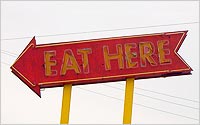 The holiday shopping season has underscored how retailers are increasingly embracing mobile platforms to lure customers and boost sales. A new report
from mobile marketing and CRM provider Cellit highlights how restaurants have turned to mobile this year, as well as bringing in new customers and building business.
The holiday shopping season has underscored how retailers are increasingly embracing mobile platforms to lure customers and boost sales. A new report
from mobile marketing and CRM provider Cellit highlights how restaurants have turned to mobile this year, as well as bringing in new customers and building business.
The findings are drawn
from a study of 9,000 mobile campaigns on behalf of 125 clients in the quick serve restaurant (QSR) industry during 2011. Most of the restaurants included in the study were franchisees of national
chains or regional franchise groups.
Coupons were a key element of many mobile campaigns. Each restaurant surveyed used a mobile coupon at least once during the year. The average mobile
subscriber list size was 791.
Cellit found the buy-one-get-one-free offer was the most effective approach, based on a survey of 796 people who opted into a national QSR mobile campaign. Nearly
seven in 10 preferred a BOGO offer, compared to only 22% who wanted price discounts, and 6% opting for “free with purchase” promotions.
Based on data from two restaurant clients
that used Cellit’s coupon redemption technology -- ranging from online and app-based solutions to point-of-sale systems -- the average redemption rate was 23%. One of the client campaigns
offered 50% off, and the other, free merchandise, with or without purchase.
When it came to the timing of campaigns, the best time to send promotional text messages was during weekdays.
Considering that the weekend is usually the heaviest time for mobile activity generally, that finding is a bit counterintuitive. The average daily number of mobile subscribers added on weekdays was
7.7 per QSR, compared to 5 on the weekends. The proportion of people who unsubscribed was also lower during the week—1.85% (per 1,000 messages sent) unsubscribed on weekdays versus 4.75% on
weekends.
Time of day also made a difference. “Sending an offer for a free dessert is probably not likely to be very effective when it is sent at 10:00 a.m. as compared to sending it at
3:00 p.m. when many customers are beginning to think about their post-work plans,” stated the Cellit report.
To maintain a client’s mobile presence without annoying users, the
company follows a formula of sending no more than one text message per week, and no less than one message a month.
The average number of campaigns that QSRs conducted was 1.8 per week and an
average of 7.9 per month, reflecting the fact that many restaurant chains segment customers on multiple distribution lists. For example, a QSR might have a database of people interested in contests
and promotions, and a second database that wants only discount offers. In that case, it typically would send one message to each database a week.
Social media, email and refer-a-friend
programs were cited in the report as useful tools to build mobile subscriber lists. Calls to action on Twitter, Facebook or in email newsletters complemented online sign-up forms to drive traffic to
mobile programs, according to Cellit. An average of 10% of people coming through the restaurants’ online channels converted to mobile.
Tapping into existing subscribers to expand lists
was another method producing results. The average participation rate for current subscribers in refer-a-friend programs was 21%, while the average conversion rate for referred friends was 6%. And the
average increase in database size after one refer-a-friend program was 16%.